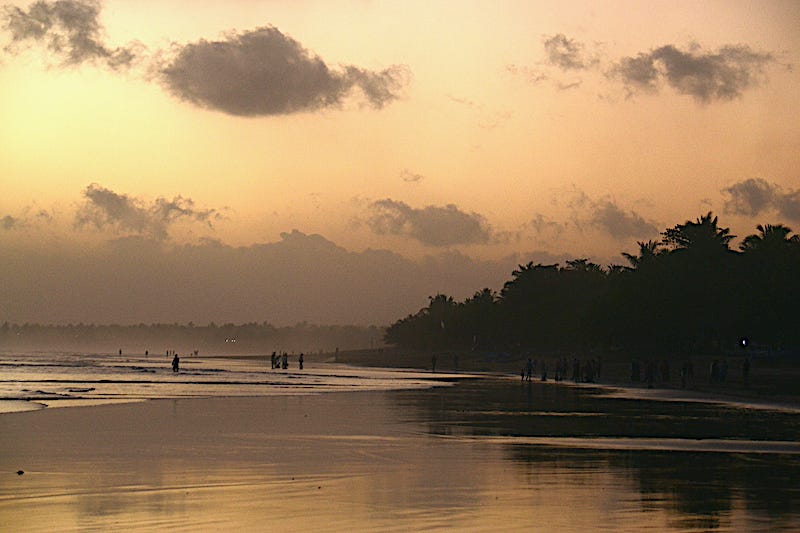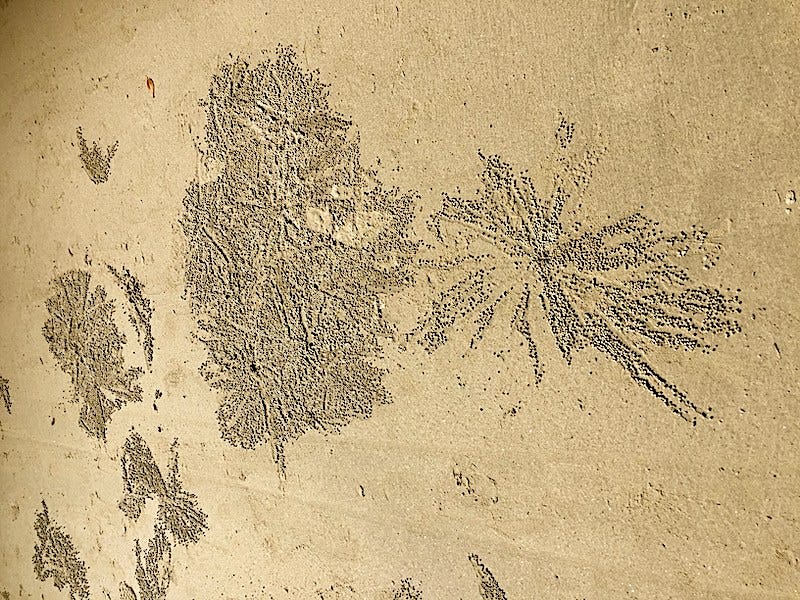Water Music for Sand Bubbler Crabs
Vestiges of Visual Communication Between an Army of Decapod Crustaceans and a Single Homo Meditatus Joggens
The music is by George Frideric Handel (1685–1759), a German-British Baroque composer.
Today’s story continues from
Before the tidal cycle reclaims the broad, deserted expanse of Pangandaran’s northern beach, the sands come alive with a flurry of activity from a community of hyperactive early risers. The morning frenzy begins in such small hours that by the time I head out for my 6 a.m. jog, my run transforms into a giant slalom, with gates popping up randomly and darting about in uncoordinated sideway movements. What are these impromptu obstacles? None other than sand bubbler crabs—Scopimera and Dotilla from the Dotillidae family—busily reshaping their sandy kingdom.
I don’t mind flea-hopping instead of jogging. After all, this is their turf so let them set the rules. And they’re a busy, endlessly curious bunch—like Minions, delightfully scatterbrained pranksters with no time to catch their breath.
After a mile or so, I start to wonder whether my lumbering, wobbly presence is intimidating their northern community. “If that’s the case, dear Minions, let the T-Rex that I am fossilise into a grand seaside statue—like the Leshan Giant Buddha*, carved from Cretaceous sandstone, I’ll stay put for a while to see what can be done about this jittery nature of yours.”
I sit down, propped against a vertical semi-fossilised sand wall, gradually sinking into a mindful stillness with only the vastness of the empty space around, gently embraced by the rhythmic lull of the waves. Tiny droplets of condensation form on my skin, while the first rays of the rising sun warm my damp eyelids. I’m attuned to the softness of the sand beneath me, the breeze playing through my hair… and something else, elusive. There’s a subtle feeling I can’t quite name. It’s as if I’m not alone on this northernmost stretch of the beach—a quiet, unsettling sense of being watched.**
On one hand, there’s a deep, quiet certainty that everything is perfectly fine. On the other, a nagging doubt stirs within my MasterMind. What should I do? Trust my gut and stay in the soothing stillness, or crack open one eye and double-check?
No matter what, the mind of this Leshan Giant Buddha—though now mostly empty—has been conditioned by eons of evolution to stay busy, curious, and safe. Inevitably, my left eye cracks open just a fraction, and the unsettling sensation of scopaesthesia is instantly confirmed: hundreds of eyes, perched on wobbly stalks, are fixed squarely on my silent frame.
Yet, as my eyelid goes all the way up, the hundreds of stalks go all the way down, sinking back into their shells. I immediately realise that vestiges of visual communication between an army of decapod crustaceans and a single homo meditatus joggens have been established.
“Why not take it from here and see what unfolds? Why not shift the decapods’ focus away from my right eye?” I ponder as I squint, moving my index finger up and down. It works! I feel like a conductor leading an orchestra of tone-deaf minions, each armed with pincers as their instruments. While an upward motion of my makeshift baton is meant to signal a standby position, the stalks, the claws or even the entire shells retreat into their burrows instead. When I bring the baton down for a decisive downbeat, the musicians scuttle away for good.
After a brief pause, the shells tentatively come out, pincers first, followed closely by the stalks, which curiously survey the surroundings. Good! Now, it’s time to adjust the tempo, introducing some poignant facets to the score with a series of smaller, slow-motion movements.
Now, a hint of hesitation hangs in the moist morning breeze, as if my ocherstra were wondering, “What does he mean? We want to scuttle in the face of motion and relax in the presence of stillness. We are binary crabs and we demand a binary notation, please!” So, I experiment with a few rounds of their binary notation, but soon grow bored and close my eyes, yearning for a deeper inner silence.
Yet my orchestra refuse to abandon their posts. They want more. They want the Giant Statue to awaken! To this end, the binary musicians gathered at the foot of the statue manage to persuade the highlanders residing in the tiny crevices of the cliff’s Cretaceous red bed sandstone to rouse the lazy conductor from his slumber.
Before long, little lumps and larger pebbles come crashing down onto my empty skull! “After the opening act, am really being thrust into yet another minuet? Do you always get what you want, you crustacean busybodies?” I ponder aloud, resigning myself to continue conducting.
* The Leshan Giant Buddha is the largest pre-modern statue in the world, and a UNESCO World Heritage Site. Located near the city of Leshan in Sichuan Province, China. It was carved into a cliff face during the Tang Dynasty, starting in 713 AD and completed in 803 AD, taking about 90 years to finish. The Buddha overlooks the confluence of three rivers—the Min, Dadu, and Qingyi—and was built to calm the turbulent waters that caused numerous shipwrecks (Wikipedia).
** The psychic staring effect (scopaesthesia) is a supposed phenomenon in which humans detect being stared at by extrasensory means. […] Brain imaging has shown that the brain cells which are activated when a test subject can see that they are being stared at are distinct from the cells activated when the starer's eyes are averted away from the subject by just a few degrees. It is theorised that the ability to precisely detect the target of a starer's gaze has conferred an evolutionary advantage by improving threat detection capabilities, as well as facilitating nonverbal communication (Wikipedia).
Photos from jogging back to the central beach:
There will be more from Pangandaran next week. And remember my dear subscriber that whatever’s been published before, can be found in the archives. Also, if you can’t find my post on Monday next week, well… it will mean that I have gone to do the next thing that is making me tick at that moment I time….










